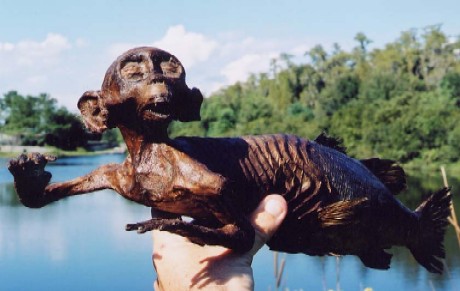
February 6, 2007

The easiest pseudocryptozoological exhibition items to have, of course, are often the gaffs and hoaxes. Among those in most cabinets of curiosities are the Feejee mermaids and the furred trouts, both taxidermy fakes. I have my share.
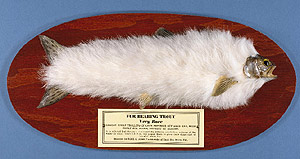
I use them to let people know these objects are often shown as “almost real” specimens. Most honest sideshow owners displaying them often merely only ask “What is It?” or “Is it Real?” But slowly the drift has been, perhaps due to eBay, for people to present these items as cryptozoological, from “unknown animals.” For cryptozoologists, we need to be aware of this trend, and go beyond it.
We must document items, of course, such as the Crookston Bigfoot, which I posted about yesterday here. But we also have to travel into the world of mistakes and gaffs.
Mistakes? Yes. Let me say something briefly about the near-cryptozoological “specimens” that are not quite fakes. One-of-a-kind items, which may be authentic but not actually from a cryptid, do exist. For example, Dr. Geoff Swinney, Curator of Lower Vertebrates, Fish, Amphibians and Reptiles, National Museums of Scotland, is shown below examining the vertebrae of the Beast of Stronsay, from the carcass of the beast found on an Orkney island beach in 1808. Swinney, who is the resident cryptozoologist in his Scottish museum, did in 1987, confirm the vertebrae was from a basking shark, and not a Sea Serpent.
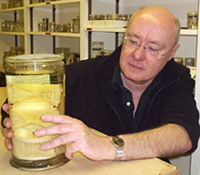
But within fakery, gaffs (the hook to get people into the metaphorical carnival tent) are just that – not what they appear to be. There are various kinds of gaffs, including those made to appear like classic examples and those which follow the current but old taxidermy hoaxing models. The Feejee mermaids are a perfect example.
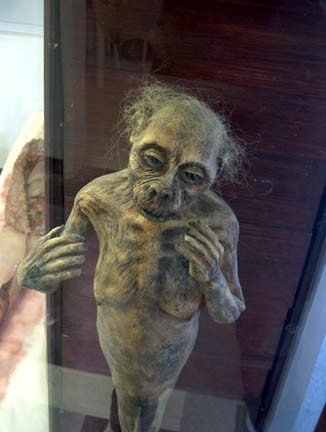
This Feejee Mermaid above is the original prop used in the movie P. T. Barnum, which was made to look like the 1866 specimen in Barnum’s American Museum.
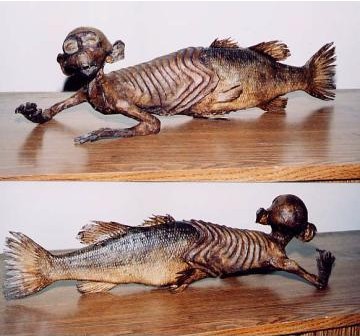
The most current type of Feejee Mermaid gaff, however, are those made from legally obtained deceased animal parts mixed together.
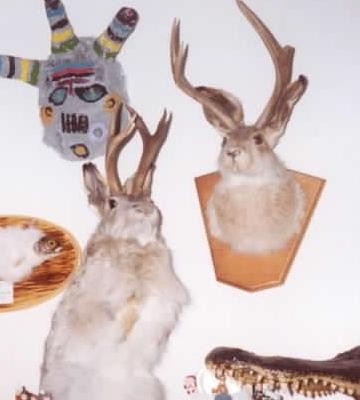
The jackalope does not exist. Some people have thought otherwise.

Do gaff makers have standards and ethics? You might be surprised. The item (above) was noted in my “Chupacabras: Mystery Solved?” posting and featured on Coast to Coast AM with George Noory’s site. Due to those discussions, in a radical professional move Doug Higley has recently written that he:
….might no longer be making ‘Chupacabras’ feeling that the fantasy concept had been abused and became more of unnecessary false claims than a fun ‘Unknown’ to ponder. The original idea was never to show the gaff ‘creatures’ claiming them to be ‘REAL!’ but to let the viewer make up their mind as to what IT was and to say only it was a strange ‘thing’ to be questioned and wondered over. It seems in at least one case the important Question Mark was dropped and Claims were made which I feel is not the proper way to to go…the entertainment aspect is diffused by the false claim. Most all the showmen/women ‘got it’ however and made a fun experience out of their shows…but like in any endeavor, there is always ‘one’ who’ll push the initial concept in an incorrect direction. The analogy to to a ‘little sci-fi movie’ is a valid one in that Universal Studios doesn’t come right out on the poster and say “The Creature is Fake! It’s a man in a rubber suit!” They let the viewer experience the fun of suspending disbelief if only for a short time…To me, it’s all about the Illusion…but then isn’t everything?….My personal view is any show ‘Gaff’ I create should have a Question Mark attached otherwise it’s just a ‘Prop’ rather than a fun ‘mystery’ to be considered. – Doug Higley
About Loren Coleman
Loren Coleman is one of the world’s leading cryptozoologists, some say “the” leading living cryptozoologist. Certainly, he is acknowledged as the current living American researcher and writer who has most popularized cryptozoology in the late 20th and early 21st centuries.
Starting his fieldwork and investigations in 1960, after traveling and trekking extensively in pursuit of cryptozoological mysteries, Coleman began writing to share his experiences in 1969. An honorary member of Ivan T. Sanderson’s Society for the Investigation of the Unexplained in the 1970s, Coleman has been bestowed with similar honorary memberships of the North Idaho College Cryptozoology Club in 1983, and in subsequent years, that of the British Columbia Scientific Cryptozoology Club, CryptoSafari International, and other international organizations. He was also a Life Member and Benefactor of the International Society of Cryptozoology (now-defunct).
Loren Coleman’s daily blog, as a member of the Cryptomundo Team, served as an ongoing avenue of communication for the ever-growing body of cryptozoo news from 2005 through 2013. He returned as an infrequent contributor beginning Halloween week of 2015.
Coleman is the founder in 2003, and current director of the International Cryptozoology Museum in Portland, Maine.
Filed under Artifacts, Chupacabras, Cryptotourism, CryptoZoo News, Cryptozoologists, Cryptozoology, Folklore, Hoaxes, Museums, Pop Culture, Sea Serpents